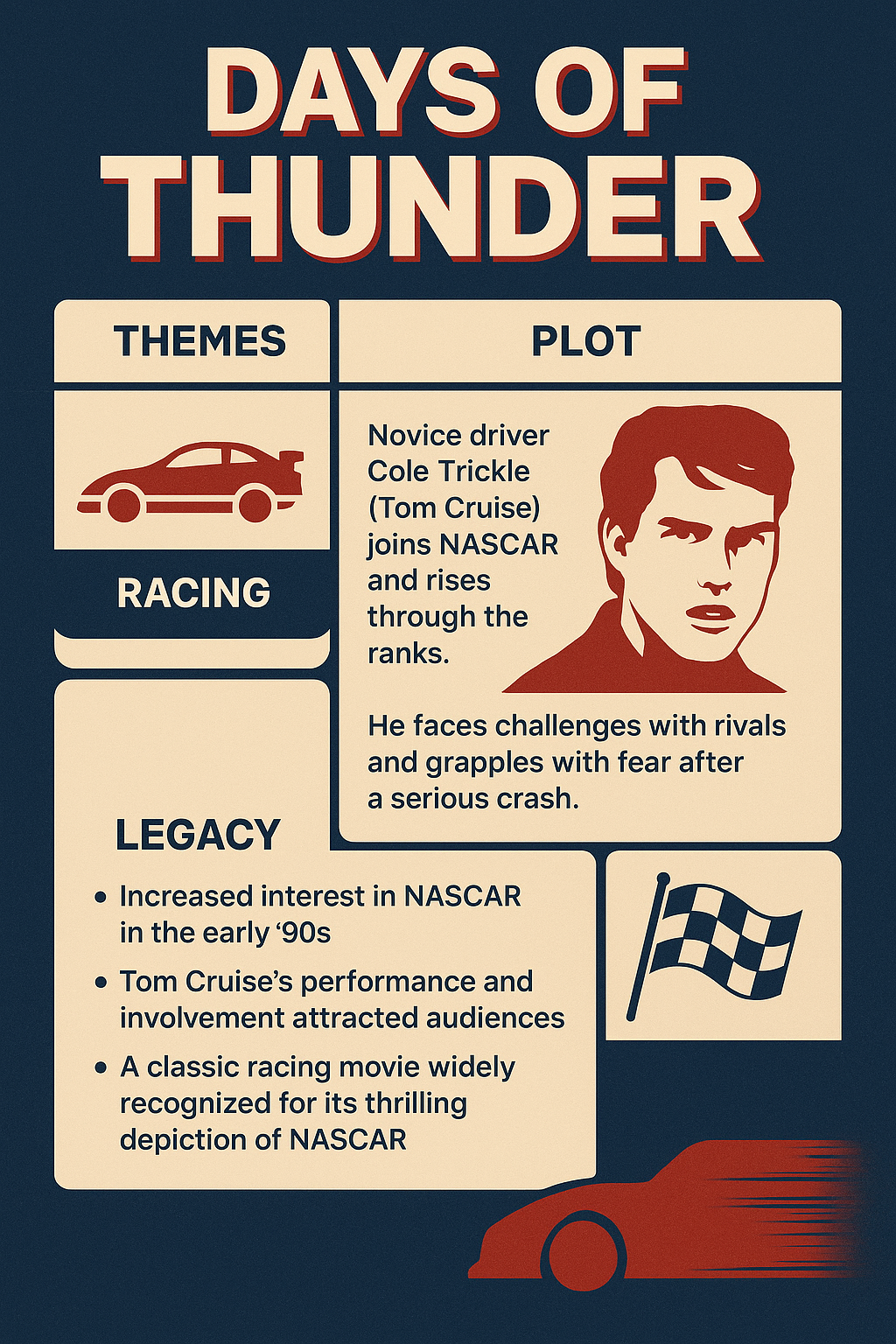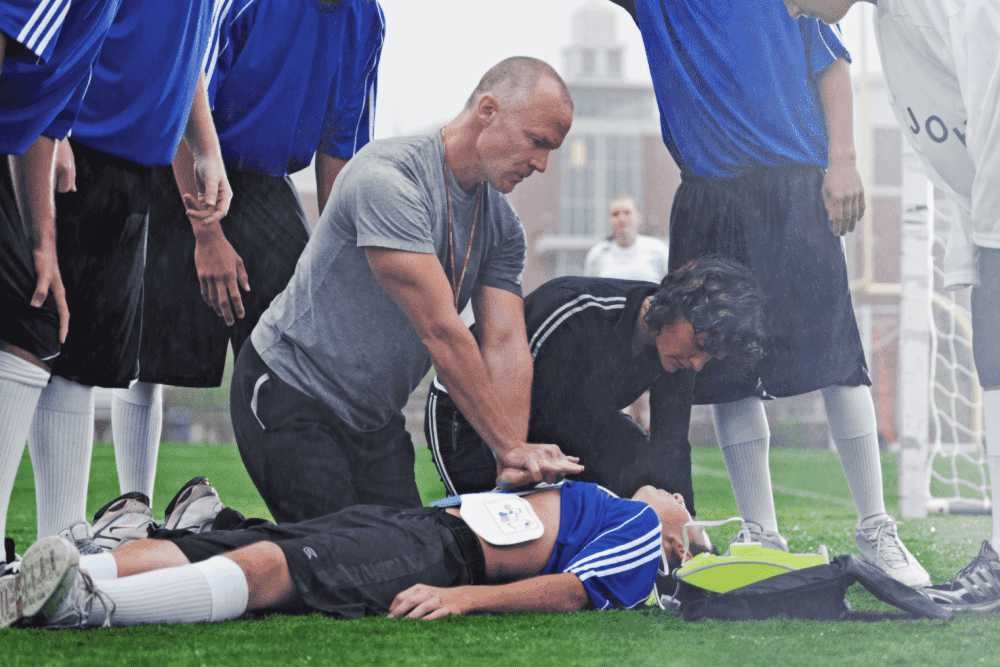When Tom Cruise starred in Days of Thunder (1990), directed by Tony Scott and produced by Don Simpson and Jerry Bruckheimer, it marked a crucial period of transformation—not just for Cruise’s career, but for the cultural spirit of late 20th-century America. The film, often described as Top Gun on wheels, wasn’t just a high-octane NASCAR drama — it was a statement about ambition, risk, identity, and resilience in a rapidly changing world.
Background: The Making of Days of Thunder
After the massive success of Top Gun (1986), the Cruise-Scott-Simpson-Bruckheimer team decided to replicate their formula of action, masculinity, and romantic drama—but this time grounded in the American heartland sport of NASCAR.
Tom Cruise immersed himself in the racing world to prepare for his role, even training with professional drivers and attending real races. He wanted authenticity, reflecting his method-acting discipline.
Notably, during the production of Days of Thunder, Cruise met Nicole Kidman, who played his love interest. Their on-screen chemistry eventually led to their real-life marriage (1990–2001), marking a major personal milestone for Cruise.
Plot Summary
Cruise plays Cole Trickle, a hotshot young race car driver from California who seeks to dominate the NASCAR scene. Guided by an older, seasoned crew chief Harry Hogge (played by Robert Duvall), Cole must overcome not just the competition, but his own ego, inexperience, and fear after a devastating crash.
Key narrative arcs include:
- Rivalries: Between Cole and fellow driver Rowdy Burns, showing how competition can turn into respect and friendship.
- Romantic Healing: Through his relationship with Dr. Claire Lewicki (Nicole Kidman), a neurosurgeon, Cole learns vulnerability and emotional strength.
- Personal Growth: From reckless youth to disciplined champion, Cole’s journey is symbolic of a larger American ideal — individualism balanced by responsibility.
Themes and Symbolism
1. Risk and Fear
The movie deeply explores the idea that growth comes through confronting fear head-on. Cole’s crash represents life’s sudden setbacks, and his recovery embodies resilience, an American cultural value.
2. Pride and Humility
Cole starts arrogant, relying on raw talent. Through setbacks, mentorship (Harry Hogge), and loss, he gains humility—recognizing that wisdom and collaboration are essential for true success.
3. American Ambition
In the late 1980s and early 1990s, America was shifting culturally and economically. NASCAR was still regional but growing nationally, symbolizing how traditional American pursuits were becoming globalized. Cruise’s portrayal of ambition captures the spirit of “go big or go home” that dominated American ethos.
4. Redemption and Brotherhood
The rivalry with Rowdy morphs into deep respect. The movie stresses that conflict isn’t always destructive—it can lead to deeper understanding, common ground, and solidarity.
5. Healing Through Love
Cole’s relationship with Dr. Lewicki shows that true healing (physical and emotional) often requires connection with others. It underscores that strength is not just endurance, but the ability to trust.
Impact on Tom Cruise’s Career
- Days of Thunder was crucial because it solidified Cruise’s image: the confident, charming, intense action-hero persona.
- It marked the beginning of his superstar “maverick archetype” — a character type he would explore more seriously in A Few Good Men (1992), The Firm (1993), and Mission Impossible (1996).
- It proved Cruise’s bankability: even with a simple racing plot, his presence alone guaranteed audience turnout.
Despite Days of Thunder receiving mixed critical reviews (many pointed to its similarities with Top Gun), it performed strongly at the box office and has since gained cult status among racing and Cruise fans alike.
Behind the Scenes: Challenges
The production was famously chaotic:
- Budget overruns.
- On-set tensions between Don Simpson, Jerry Bruckheimer, and the studio executives.
- Constant script rewrites — often happening on the day of shooting. Despite all this, the energy of the film never faltered, perhaps because chaos fed into the realism of high-risk racing.
Legacy
Today, Days of Thunder remains significant for several reasons:
- It introduced millions of Americans and global audiences to the world of NASCAR.
- It demonstrated that Tom Cruise wasn’t a one-hit action wonder but a durable star capable of carrying entire industries on his back.
- It captures a snapshot of early-1990s optimism and bravado — a world still believing in the American dream of self-made success.
And of course, the iconic line:
“Rubbin’, son, is racin’!” — still echoes today in racing culture.
In Conclusion
Days of Thunder wasn’t just about fast cars and flashy action — it was about identity, fear, pride, redemption, and love.
It mirrored Tom Cruise’s personal trajectory: a young star learning how to handle fame, personal relationships, and career ambition at top speed. And, just like Cole Trickle, Cruise managed to stay on the track—and become one of Hollywood’s most enduring figures.






